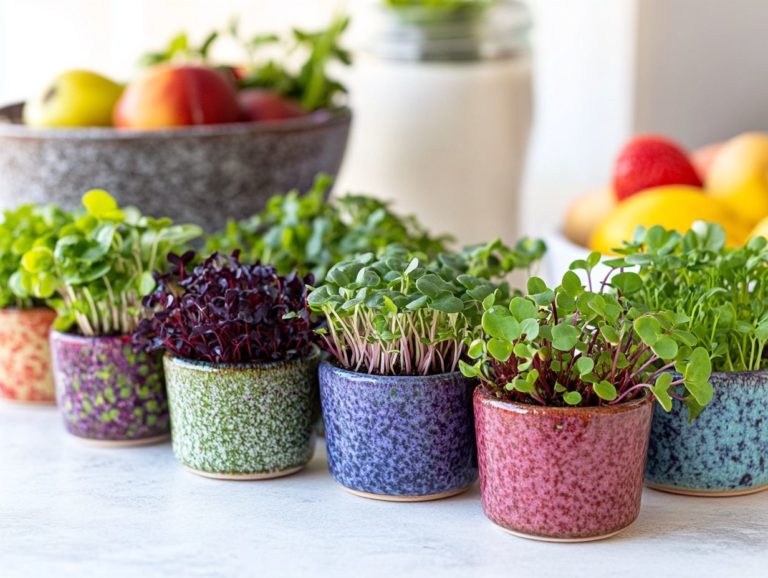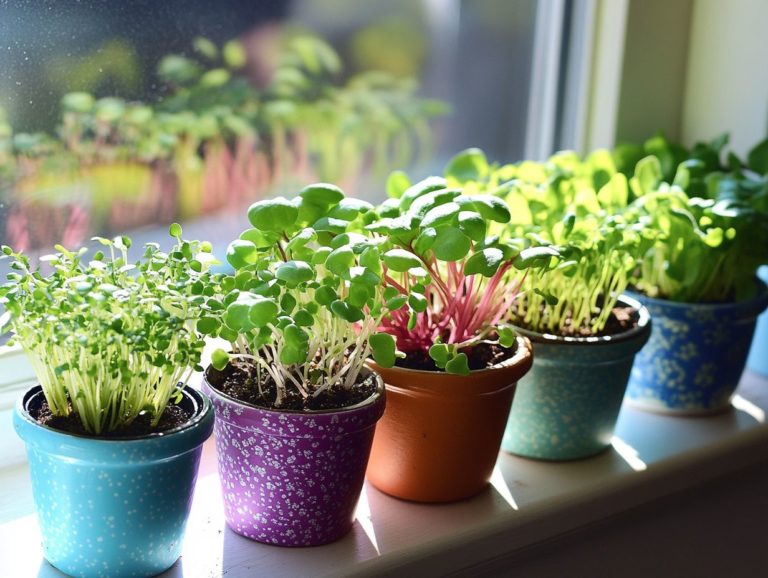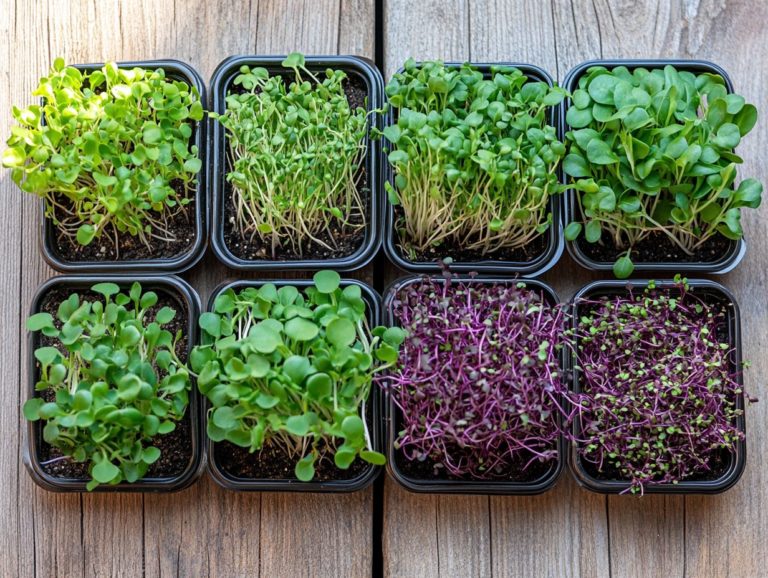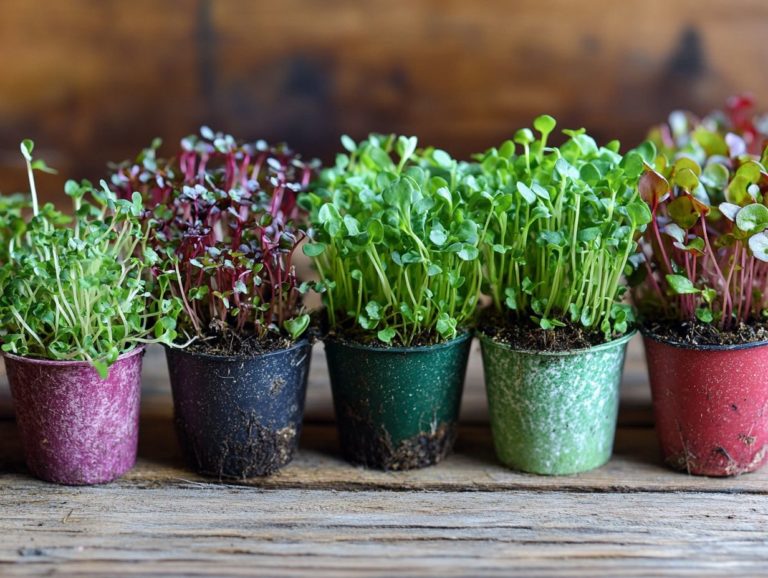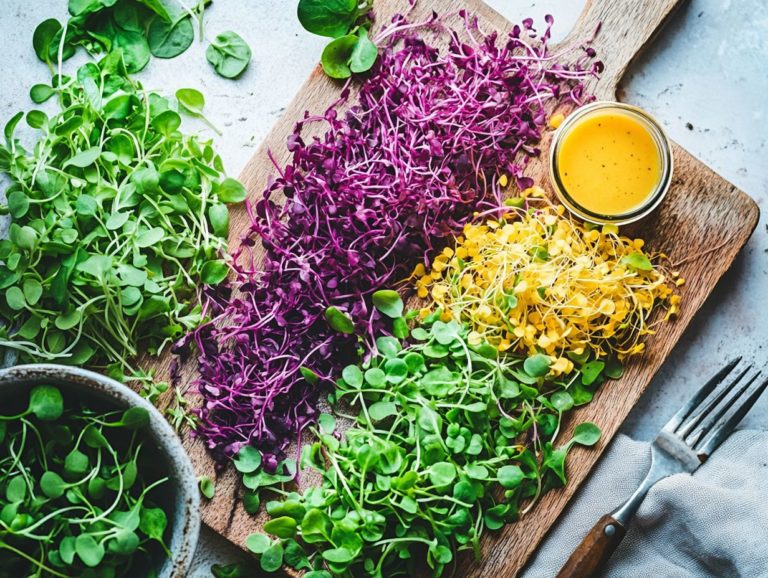Microgreen Varieties for Culinary Professionals
Microgreens are a culinary sensation that can infuse your dishes with vibrant flavors and essential nutrients.
This guide explores what microgreens are, their unique characteristics, and their remarkable benefits. You ll find popular varieties and tips on how to grow and source them.
Discover how microgreens can transform your cooking into an exciting adventure!
Contents
- Key Takeaways:
- What are Microgreens?
- Benefits of Using Microgreens in Cuisine
- Popular Microgreen Varieties
- Best Uses and Pairings
- Growing and Harvesting Microgreens
- Step-by-Step Guide for Culinary Professionals
- Sourcing Microgreens for Restaurants
- Incorporating Microgreens into Menu Planning
- Cooking Tips for Using Microgreens
- Frequently Asked Questions
- What are microgreen varieties?
- Why are microgreen varieties popular among culinary professionals?
- What are some common microgreen varieties used by culinary professionals?
- Are all microgreen varieties safe to consume?
- Can microgreen varieties be grown at home for personal use?
- How should culinary professionals use microgreen varieties in their dishes?
Key Takeaways:
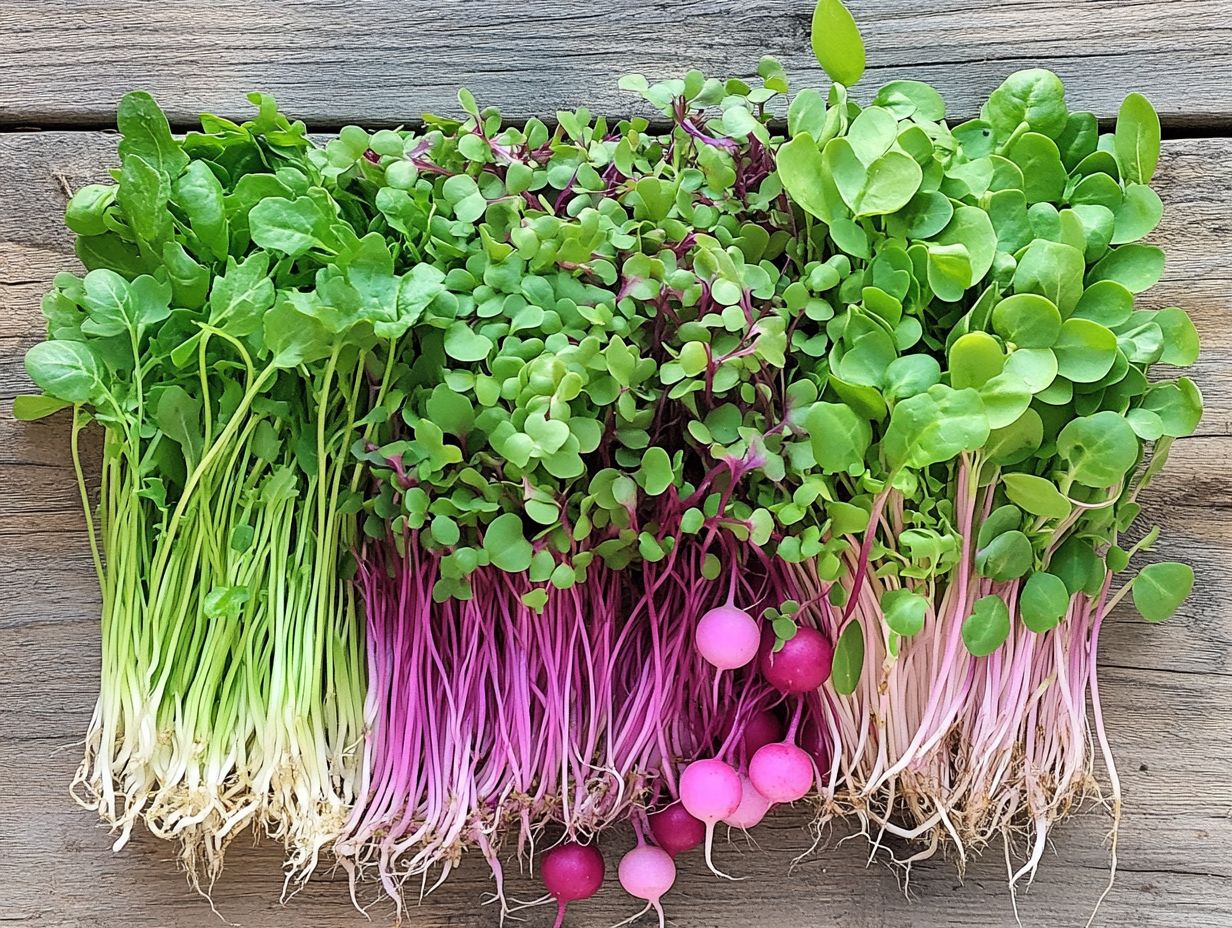
- Microgreens are young, tasty plants that add flavor and beauty to dishes.
- They offer health benefits and enhance the taste of your meals.
- Chefs can easily grow and use different microgreens for creative dishes.
What are Microgreens?
Microgreens are young, edible greens that are gaining popularity in cooking. They enhance dishes with their flavors, textures, and eye-catching looks.
These small plants, like broccoli and cilantro microgreens, are packed with nutrients and can make your meals pop with color and taste.
Benefits of Using Microgreens in Cuisine
Microgreens are not just pretty; they bring impressive health benefits to your meals. They are full of essential vitamins and antioxidants.
Adding these tiny greens boosts flavor and adds visual appeal to your dishes.
Popular Microgreen Varieties
Microgreen varieties offer delightful flavors and health benefits. Broccoli and cilantro microgreens are popular for their robust flavors.
Try arugula for some peppery kick or basil for a fragrant touch. Vibrant choices like beetroot and sunflower shoots add color and taste to any dish.
Overview of Different Types
The culinary world is rich with microgreens that can elevate your dishes. Each variety, like broccoli and cilantro, brings its unique flavors and nutrients.
Sunflower microgreens add a nutty flavor, while pea shoots bring a sweet, tender touch. Incorporate these greens into your meals for added health and taste.
Experiment with saut ing or mixing them into dressings for a burst of flavor!
Best Uses and Pairings
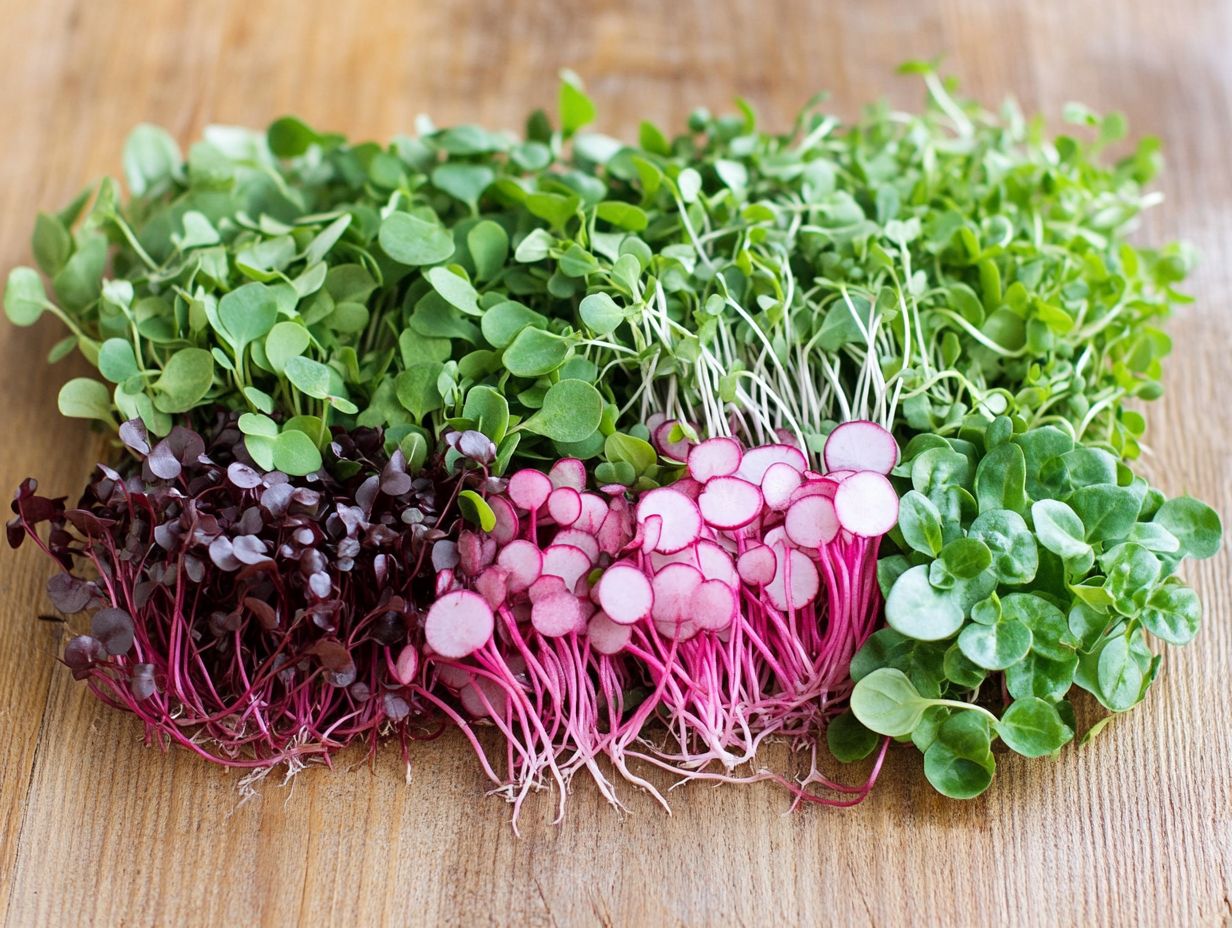
Incorporating microgreens into your dishes can truly elevate your cooking. They add layers of flavor, delightful textures, and stunning visual appeal to your meals.
Imagine using vibrant microgreens like basil or arugula to invigorate a simple pasta dish. They bring a fresh burst of flavor and a splash of color that transforms the ordinary into the extraordinary.
For salads, mix a variety of microgreens, such as pea shoots and mustard greens, to introduce contrasting tastes and textures. This ensures each bite dances on your palate.
When it comes to sandwiches or wraps, these greens offer a creative alternative to traditional leafy lettuce, infusing a gourmet touch without overpowering the dish. Don t stop there garnish soups or tacos with zesty microgreens to enhance visual appeal and impart subtle flavors.
Growing and Harvesting Microgreens
Growing and harvesting microgreens offers a rewarding experience. You can elevate your culinary creations with fresh, nutrient-rich ingredients while adhering to local health standards.
This journey begins with selecting high-quality organic seeds from trusted sources like Bootstrap Farmer or True Leaf Market. After choosing your seeds, taking good care of these small plants is essential until they reach their peak flavor and nutritional value.
To ensure a clean and efficient collection, use the right harvesting scissors. They re your best ally in this flavorful endeavor.
Step-by-Step Guide for Culinary Professionals
Culinary professionals eager to grow microgreens can easily follow a step-by-step guide to streamline the process. This ensures the production of high-quality, nutrient-dense ingredients.
Start by selecting organic seeds. Then, move on to proper soil preparation, seed planting, and optimal watering techniques. Remember, using harvesting scissors is key for a clean cut, preserving the delightful textures and exceptional flavors of your microgreens.
Begin with the right seed varieties, such as radish, basil, or arugula, as each brings its unique flavors and nutritional benefits to the table.
When preparing the soil, mix it with peat moss a soil amendment that improves drainage to enhance aeration while keeping a slightly acidic pH.
After evenly planting the seeds, cover them lightly with soil to encourage uniform growth. Keep a close eye on moisture levels to ensure your microgreens thrive! Mist the soil lightly to avoid over-saturation.
Once it’s time to harvest, rinse the microgreens gently and store them in a cool, dark place to maintain their freshness.
By implementing these practical tips and best practices, you can elevate your dishes with vibrant, homegrown microgreens that are sure to impress.
Sourcing Microgreens for Restaurants
Sourcing high-quality microgreens is crucial for you as a restaurant owner. Elevate the dining experience while prioritizing freshness and nutritional value.
As a culinary professional, you can find microgreens from various suppliers, including local health food stores and farmers markets, which often showcase seasonal varieties.
You can also find microgreens on online platforms like Amazon. These provide a convenient option, offering a diverse selection of organic seeds and top-notch microgreens, making it easier than ever for you to access the best ingredients for your kitchen.
Where to Buy and How to Ensure Quality
Prioritize quality by choosing reputable sources. Look for those that emphasize freshness and sustainability.
Health food stores and farmers markets are fantastic spots to discover locally-grown options. Meanwhile, online retailers like Bootstrap Farmer and True Leaf Market offer organic seeds and ready-to-harvest microgreens, making it easy for chefs to uphold high standards.
Pay close attention to the appearance of the microgreens as you browse. They should be vibrant in color, free from wilting or discoloration, and devoid of any mold. A strong, fresh aroma is also a key indicator of quality. For more insights, refer to our quick guide to common microgreen varieties.
When making your purchase, don t hesitate to ask the seller about their growing practices and how long the microgreens stay fresh after purchase. These details significantly impact both taste and nutritional value. If you re opting for online shopping, take the time to read customer reviews to gauge the seller s credibility.
By following these best practices, you ll not only select the finest microgreens but also elevate your culinary creations and health benefits.
Incorporating Microgreens into Menu Planning
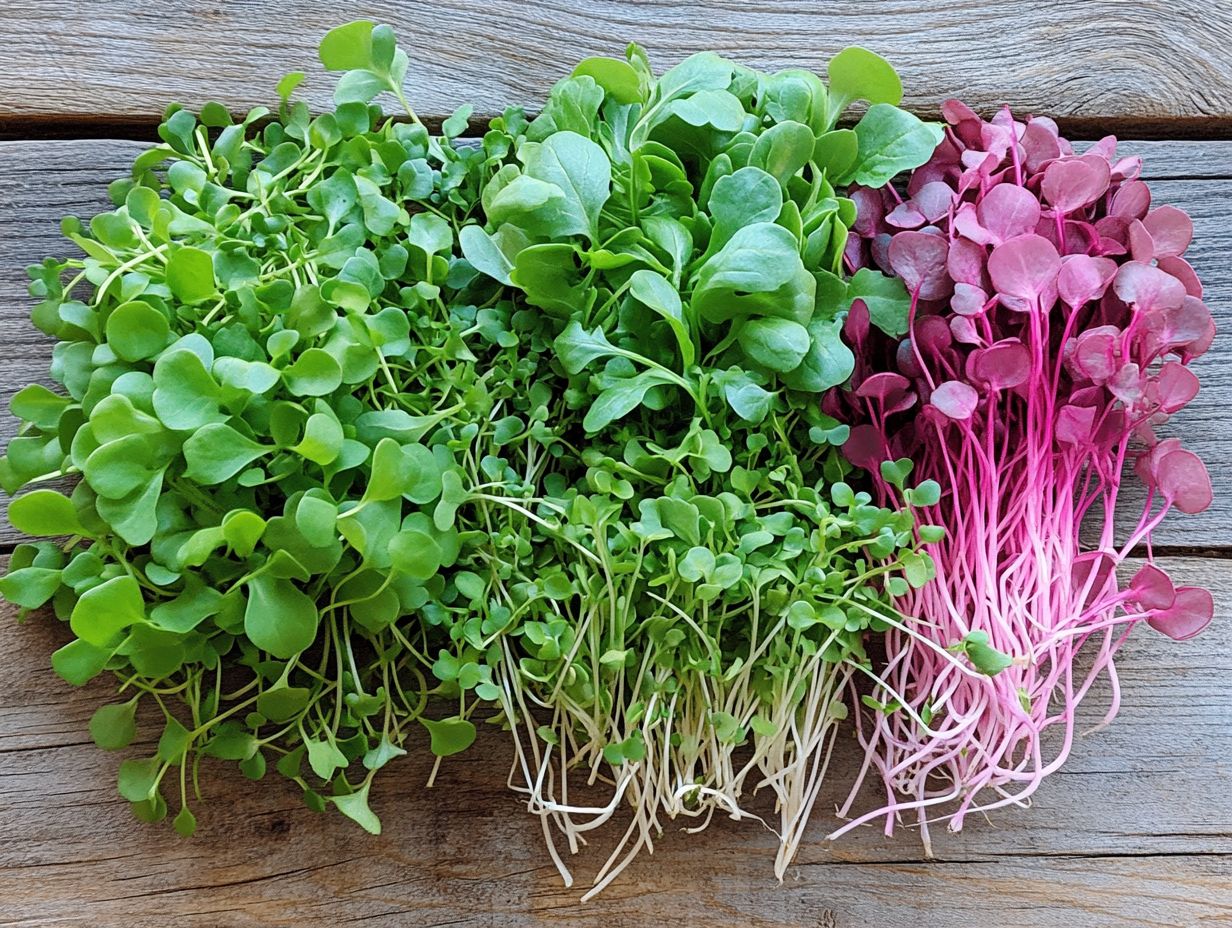
Incorporating microgreens into your menu planning can dramatically elevate the culinary appeal and flavor profiles of the dishes you offer. This allows you to craft truly innovative masterpieces in the kitchen.
Thoughtfully integrating these vibrant greens can transform everyday meals into exceptional dining experiences, complete with delightful textures and robust flavors. The unique palette of microgreen varieties can also serve as inspiration for new recipes and seasonal offerings, keeping your menu fresh.
Ideas and Inspiration for Creative Dishes
Microgreens open up a world of delicious possibilities for you to craft innovative and visually stunning dishes that are sure to captivate your diners.
Imagine incorporating delicate pea shoots into a fresh spring salad drizzled with a zesty citrus vinaigrette; it will elevate the entire dining experience, offering a bright, sweet crunch that delights. For more insights, check out the microgreen varieties: taste and flavor guide. Garnish your avocado toast with spicy radish microgreens, and you not only enhance its flavor but also introduce a vibrant pop of color that’s practically begging to be showcased on Instagram.
Consider experimenting with a vibrant microgreen pesto, blending basil and kale shoots. This sauce will take your pasta dishes to the next level! By pairing seasonal ingredients with these tiny greens, such as heirloom tomatoes in the summer or roasted butternut squash in the autumn, you can create dishes that celebrate the best each season has to offer. Additionally, exploring the benefits of growing diverse microgreen varieties can keep your menu irresistibly enticing.
Cooking Tips for Using Microgreens
Cooking with microgreens can elevate your dishes, infusing them with vibrant colors, intriguing textures, and delightful flavors that tantalize the taste buds.
To fully harness their potential, it s crucial to grasp the finest culinary techniques for incorporating these delicate greens into your meals.
Whether you re garnishing entrees or weaving them into sauces and salads, microgreens present a wealth of opportunities to enhance both taste and presentation.
Don t miss out on the chance to impress with beautiful colors and exciting flavors!
Explore new microgreens today and transform your dishes!
Creative Ways to Use Microgreens
Exploring creative ways to use microgreens can spark your cooking creativity. You can elevate your dishes in delightful and unexpected ways. Whether you re garnishing soups and salads with a sprinkle of vibrant microgreens or blending them into smoothies for an extra nutritional punch, don t miss out on trying these delightful greens in your next dish your taste buds will thank you!
Their subtle flavors and striking visual appeal make them a great addition to any kitchen.
Imagine a gourmet sandwich bursting with flavor! Layer it with aromatic microgreens like basil or cilantro, enhancing the flavors of roasted meats and cheeses while adding a satisfying crunch. You can also infuse microgreens into your homemade pestos, which is a sauce made from crushed basil, garlic, and nuts, or dressings. For an even greater nutritional boost, consider using the best microgreens for nutritional value. This not only intensifies the taste but also brings a beautiful color contrast to your creations.
Using microgreens as a topping for savory tarts or even pizzas can transform everyday dishes into extraordinary culinary delights.
Both chefs and home cooks can experiment with the diverse range of microgreens available, uncovering their unique characteristics to craft visually stunning and flavor-packed meals that are sure to impress.
Frequently Asked Questions
What are microgreen varieties?
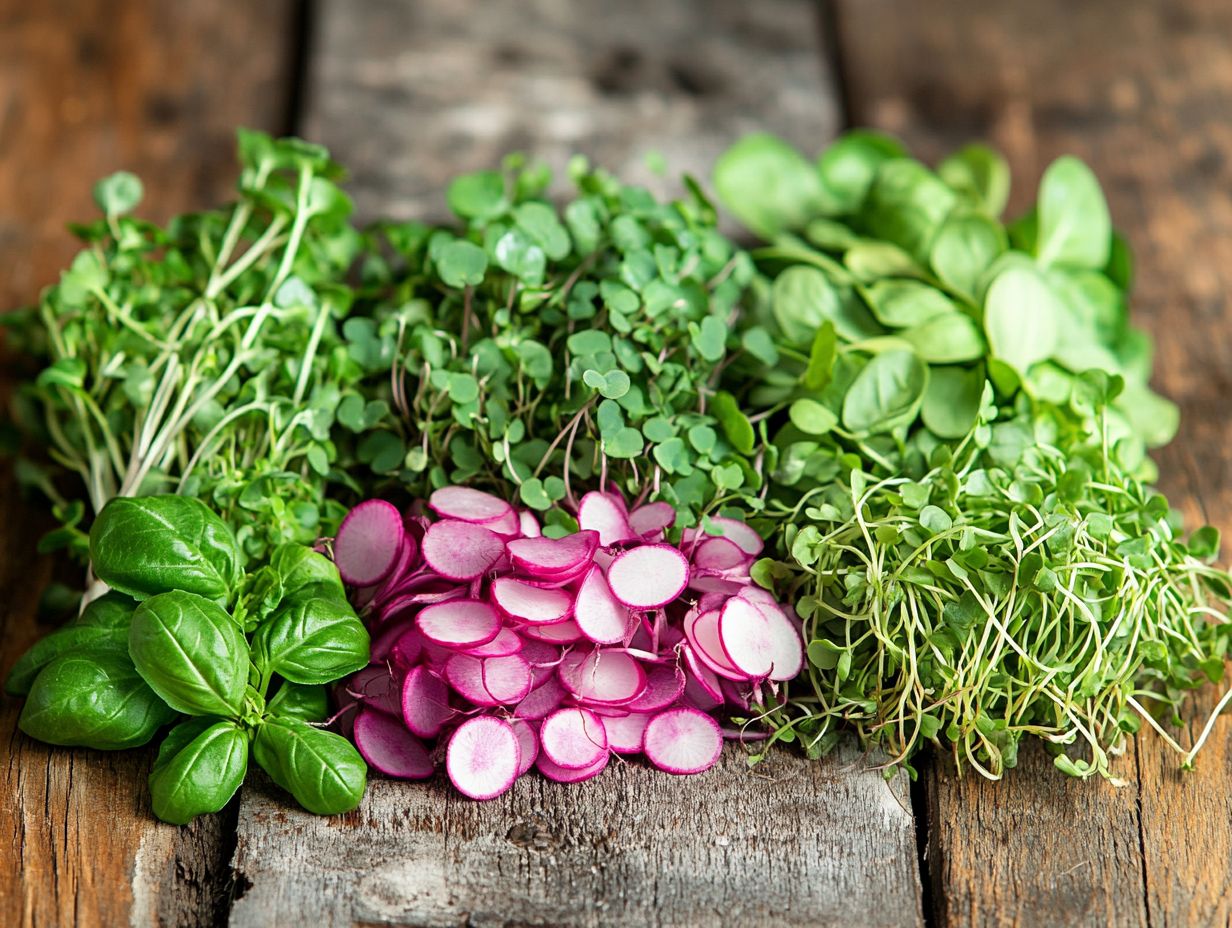
Microgreen varieties are young vegetable plants harvested at a very early stage, typically within 1-3 weeks of sprouting. They are smaller than baby greens but bigger than sprouts, making them perfect for use in culinary dishes.
Why are microgreen varieties popular among culinary professionals?
Microgreen varieties are popular among culinary professionals because they offer a wide range of flavors, textures, and colors to enhance the presentation and taste of their dishes. They are also packed with nutrients, making them a healthy and delicious addition to any dish.
What are some common microgreen varieties used by culinary professionals?
Some common microgreen varieties include basil, cilantro, arugula, radish, broccoli, and pea shoots. These are just a few examples, as there are countless varieties of microgreens available for chefs to experiment with.
Are all microgreen varieties safe to consume?
Yes, all microgreen varieties are safe to consume, as long as they are grown and harvested under proper conditions. It is important to source microgreens from reputable suppliers and to thoroughly wash and inspect them before use.
Can microgreen varieties be grown at home for personal use?
Yes, microgreen varieties can be easily grown at home for personal use. They require minimal equipment and space, making them a great option for those who want to have a constant supply of fresh microgreens for their culinary creations.
How should culinary professionals use microgreen varieties in their dishes?
Culinary professionals can use microgreen varieties in various ways. They can incorporate them into salads, garnish dishes, add them as a topping on sandwiches or pizzas, or even blend them into smoothies for an extra boost of nutrients. The possibilities are endless!
Why not give growing your own microgreens a try? They re easy to cultivate and can truly elevate your meals!

